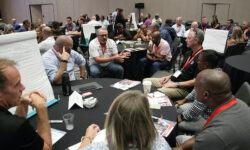How NFPA Committees Develop Codes
While NFPA 72 is the most widely referenced document for installing fire system contractors, the codes and standards it contains are a distillation from a host of other influential organizations and governing bodies.

How Inputs and Voting Proceeds
Through ANSI’s Essential Requirements, any member of the public may submit a comment to a TC for consideration. NFPA is in a transition at this time from the former process of Public Proposals and Public Comments to Public Inputs. In the past, the TCs held a Report on Proposals (ROP) meeting and a Report on Comments (ROC) meeting. This has now changed to a First Draft and Second Draft Meeting. The former process had the TC voting on each proposal or comment, which could end up being very confusing to the TC, especially when various changes to a sentence or paragraph were submitted. The new process allows the committee to vote on the final wording of the document and not on each modification that was submitted to achieve the final text.
At the TC meeting a simple majority of the members present may pass an item. This, however, is not the final vote. A letter ballot is then sent out to all principal and alternate members. For a motion to carry, two-thirds of the members voting must agree to an item. Therefore, an item that may have been a close vote at the TC meeting may not pass the letter ballot.
While there are a number of Public Inputs from the public, the majority tend to come from members of the TC. Any member of the public may speak at a TC meeting, but permission must be obtained in advance from the TC chair, and time to speak is usually limited. An interested party has greater influence as a member of a TC than one who is not a member.
Once the letter ballot has been completed, NFPA will publish a First Draft Report. This document allows the public to view the actions taken by the TC. Anyone may submit a Public Comment on any action that was taken during the First Draft Meeting. It is important to note that one may not submit new inputs at this time. The time for new ideas is only during Public Inputs prior to the First Draft Meeting. The Second Draft Meeting is similar in that it a simple majority can pass a motion, but a two-thirds member vote is required to move a motion on the letter ballot.
Security and Fire Accredited Standards Developers
- ASIS Int’l
- Central Station Alarm Association (CSAA)
- Electronic Security Association (ESA)
- FM Approvals
- International Code Council (ICC)
- National Electrical Contractors Association (NECA)
- National Electrical Manufacturers Association (NEMA)
- National Fire Protection Association (NFPA)
- Security Industry Association (SIA)
- Underwriters Laboratories Inc. (UL)
Related Articles:
- Follow NFPA-1600 When Developing Your Emergency Management Program
- Watch Our Webinar on Campus Fire Alarms & Mass Notification
- Cracking the 2013 National Fire Alarm Signaling Code
- Unlocking the 2013 Edition of NFPA 72
- Video Can Prove Valuable in Fire Applications
- Navigating the Complexities of Emergency Notification Systems Integration
Shane Clary, Ph.D., has more than 37 years of security and fire alarm industry experience. He serves on a number of NFPA technical committees, and is vice president of Codes and Standards Compliance for Pancheco, Calif.-based Bay Alarm Co. He can be reached at smclary@bayalarm.com.
If you appreciated this article and want to receive more valuable industry content like this, click here to sign up for our FREE digital newsletters!
 Leading in Turbulent Times: Effective Campus Public Safety Leadership for the 21st Century
Leading in Turbulent Times: Effective Campus Public Safety Leadership for the 21st Century
This new webcast will discuss how campus public safety leaders can effectively incorporate Clery Act, Title IX, customer service, “helicopter” parents, emergency notification, town-gown relationships, brand management, Greek Life, student recruitment, faculty, and more into their roles and develop the necessary skills to successfully lead their departments. Register today to attend this free webcast!







